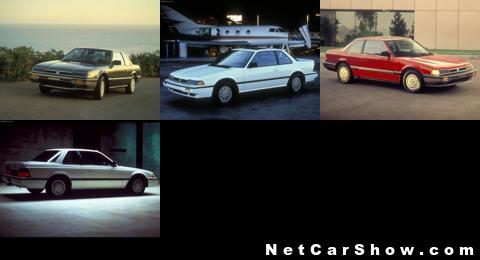Honda Prelude Si
The Honda Prelude was a front wheel drive I4-engined coupe that was manufactured by Honda between 1978 and 2001. It spanned five generations of cars but was discontinued upon the release of the fourth-generation Honda Integra in Japan in late 2001, due to its decreasing sales and popularity.
The Prelude's perennial competitor has been the Toyota Celica, another I4-powered coupe introduced several years prior to the Prelude. Throughout the 1980s, it was challenged by the Nissan Silvia, Isuzu Impulse, Mitsubishi FTO, Mitsubishi Cordia (later the Eclipse), and the Mazda MX-6.
1978
The first generation Prelude was released in 1978, and was the third main model in Honda's modern lineup, joining the Civic and the Accord. Styling of the car was a combination of both then current Civic and Accord. The Prelude was equipped with a 1751 cc SOHC CVCC I4 engine that produced 72 hp and 94 lbf-ft of torque with a 5-speed manual transmission, and 68 hp with a 2-speed automatic called the Hondamatic.
1983
The second generation Prelude was released in 1983 and was initially available with a 1.8-litre 12-valve carburated engine, producing 100 hp, and fuel injection was introduced in 1985 - in the "Si" models. In Japan, Asia and Europe, it was available with a 2-litre DOHC 16-valve PGM-FI engine, although this engine was not released until 1986 in Europe. The second generation Prelude was the first to have pop-up headlights; this allowed for a more aerodynamic front which reduced drag. Opening the headlights however, especially at higher speeds, produced more drag.
When the 2-litre 16-valve DOHC engine came out, the hood was slightly modified since the larger engine could not be fitted under the stock hood. The European version also saw slight modifications to the taillights and revised front and rear bumpers which were now color-matched. Due to the fairly low weight of the car (1,025 kg) and high power (the 16-valve engine produced 137 hp) the car was surprisingly nimble, something most Preludes were not in comparison to their competitors, until the VTEC engines came out.
1988
The third generation Prelude was similar to the second generation, however it gained four wheel steering on some models, as well as a 2.0 L SOHC carburated engine, an optional B20A DOHC EFI engine, or a slightly-larger B21A1 in 1990 and 1991.
The four wheel steering system on the third generation prelude was an extraordinary piece of engineering in itself. As of 2006, it is the only four wheel steering system on a production car that is entirely mechanical in its design; that is, there is always a direct mechanical connection between the steering wheel and the rear wheels. This means the four wheel steering-equipped Prelude was intuitive to drive, unlike most other four wheel steering systems in which the rear wheels were controlled indirectly by a computer.
The third generation Prelude also had some new external designs worth mentioning. The hoodline was designed to be the lowest hoodline of any front wheel drive car in the world, allowing for better forward visibility. The drag resistance was at of high-speed stability.
Another unique structural element of the third generation Prelude was the high-strength metal used in the 6 roof pillars. The roof pillars were so slim that all-around visibility was amazingly clear for 326°. Some call this Prelude the "baby NSX" due to some common design cues between the two cars, such as the excellent forward visibility via a low hoodline, a front end resemblance, the suspension attributes (great handling with a smooth ride).
In 1987, Road & Track published a test summary that shows the 1988 Honda Prelude 2.0Si 4WS outslalomed every car of that year, including all Lamborghinis, Ferraris, and Porsches. It went through the slalom at 65.5 mph, which was amazing in those days. For reference, the 1988 Corvette did the same at 64.9 mph.
The Prelude was Wheels magazine's Car of the Year for 1987.
This article is licensed under the GNU Free Documentation License. It uses material from Wikipedia.







![2025 Audi S5 Sedan [US] 2025 Audi S5 Sedan [US]](/R/Audi-S5_Sedan_US-Version-2025-thb.jpg)
![2025 Audi A5 Sedan [US] 2025 Audi A5 Sedan [US]](/R/Audi-A5_Sedan_US-Version-2025-thb.jpg)
![2025 Kia EV6 GT [UK] 2025 Kia EV6 GT [UK]](/R/Kia-EV6_GT_UK-Version-2025-thb.jpg)



![Audi R8 V10 performance RWD [UK] (2022)](/R/Audi-R8_V10_performance_RWD_UK-Version-2022-ec-601a90b329c913612c201ebc20a4ece2be.jpg)












![2004 Honda Accord iCTDi [EU] 2004 Honda Accord iCTDi [EU]](/R/Honda-Accord_iCTDi_European_Version-2004-thb.jpg)








